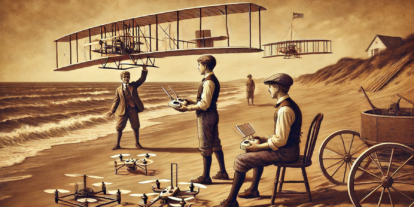On September 12 in San Bruno, CA, Kittyhawk took part in a joint UAS Remote ID demonstration with Wing, AirMap, AiRXOS (part of GE Aviation), ANRA, Skyward (A Verizon company), Uber, UASidekick, CNN AIR, and Flite Test. Operating a variety of aircraft simultaneously and in controlled airspace via LAANC, the companies were able to successfully use draft ASTM standards for network-based remote ID solutions in support of transparency, while protecting the data of drone operators. Kittyhawk also participated in the first InterUSS demonstration of network-based Remote ID announced this January.
Under the standard, commercial drone operators and hobbyists alike can choose to make limited aircraft identification data available in certain situations with security limits to prevent aggregation of operator information. During the recent demonstration, Kittyhawk customer CNN Aerial Imagery & Reporting unit (CNN AIR) was able to be identified as an authorized commercial flight while using the Kittyhawk platform. There were no additional steps for them to take, and leveraging the power of the InterUSS system, their information was available to all key stakeholders in real time.
CNN AIR has been a consistent advocate for workable Remote ID solutions as part of their commitment to the ecosystem of responsible drone operators. As an FAA pathfinder member, CNN AIR has been championing more advanced operations from their inception.
Law enforcement works closely with media outlets as they cover news with drones. News organizations want to share that there is an authorized drone flying while law enforcement want to verify drones in the area aren’t compromising their response or unauthorized to be at the scene. Remote identification based on ASTM standards enables operators to identify themselves to the public, but share limited information only when necessary.
For Kittyhawk customers in all industries, Remote ID enablement can be as simple as a setting in our fleet management tools or an integration with our APIs. That’s why we will remain strong proponents of interoperable solutions that give customers more control while enabling a safer and more dynamic airspace.
As a product-first company, we take our cues from our customers who overwhelmingly tell us that they want to adhere to a higher level of compliance than the regulations require. They want to share more information with more stakeholders. They want more detailed guidance about…everything. It’s the space between what’s required today and what’s possible tomorrow where Kittyhawk exists.
As more and more advanced operations are taking place in the NAS, InterUSS and Remote ID are going to become increasingly critical. One of the particularly novel aspects to this demonstration was the diversity of the participants. It was emblematic of where aviation is going in the near future where drone hobbyists, commercial Part 107 operators and Part 135 operations are safely able to co-exist. In particular, the increasing viability of 135 operations are a sign of the FAA’s flexibility and forward thinking that demonstrate advanced operations aren’t a pipe dream. They’re on the way. And of course at their core are good communication and transparent identification.
This demonstration shows that performance based-standards and industry collaboration can produce innovation at a rate which will enable the state of the art to move ever higher, ever faster.
Joshua Ziering
Joshua is the Founder and Chief Security Officer of Aloft (formerly Kittyhawk), the market leader in drone airspace systems & UTM technologies. He is also a Part 61 certificated private pilot, a founding member of the FAA's Drone Safety Team, and an FAA Part 107 certificate holder.



